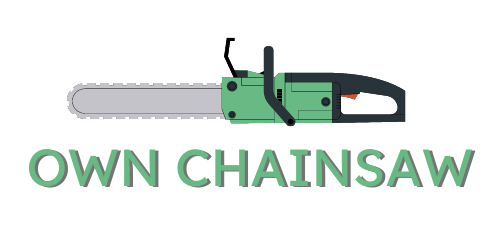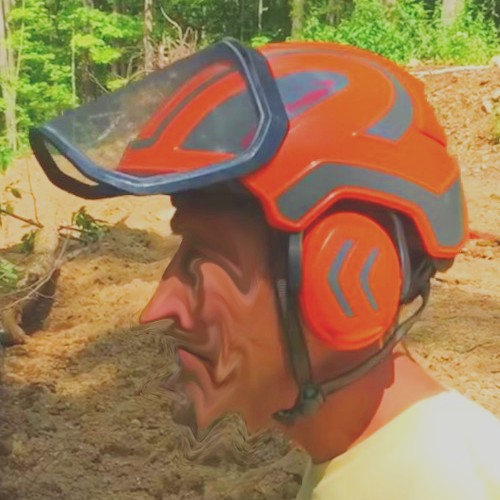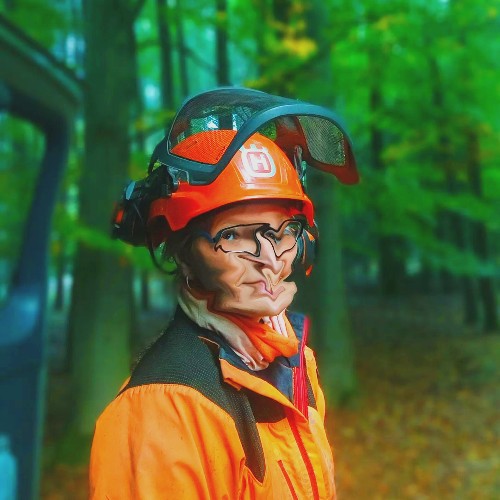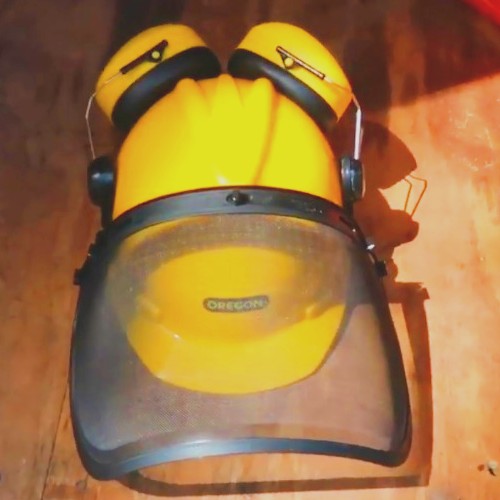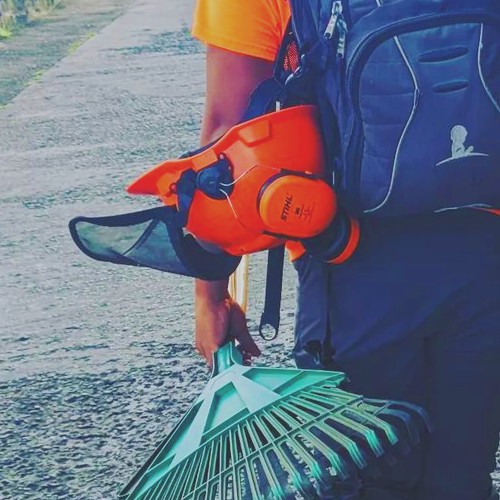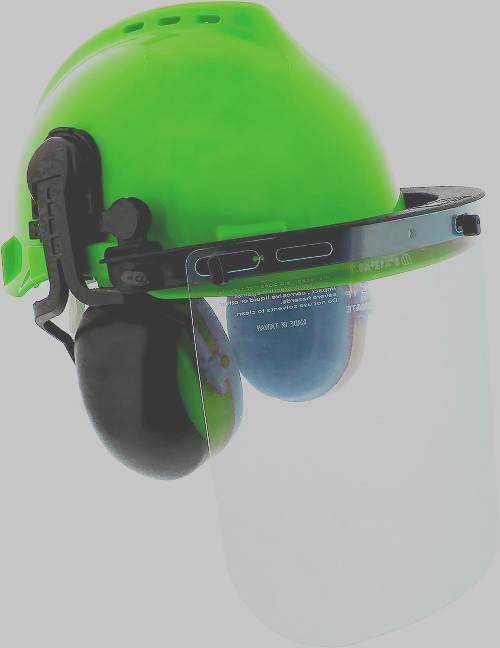We are all well aware of the bothersome nature of chainsaws…quite literally! They not only emit an ear-splitting noise but also tend to fling debris and sawdust that can cause severe damage to your skin or even result in visual impairment.
How alarming! However, fret not, my esteemed companions, for there exists a remedy to this predicament – the finest chainsaw helmets!
Editor’s Pick
TR Industrial 88011 Helmet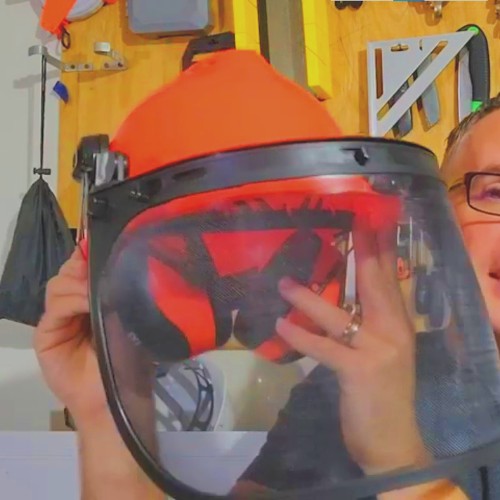
- Color: Orange
- Material: Polycarbonate
- Weight: 2.6 pounds
Budget Pick
NEIKO 53880A Forestry Helmet
- Color: Yellow
- Material: Plastic, Steel Mesh
- Weight: 2.49 pounds
These remarkable helmets are equipped with a specialized face shield that serves as a shield, effectively safeguarding your face and eyes against the perilous projectiles of debris and sawdust.
Moreover, they boast an unparalleled level of comfort, featuring adjustable straps and foam cushioning to alleviate the weight and pressure on your cranium.
According to the Occupational Safety and Health Administration (OSHA), wearing a helmet while operating a chainsaw can significantly reduce the chance of head and eye injury.
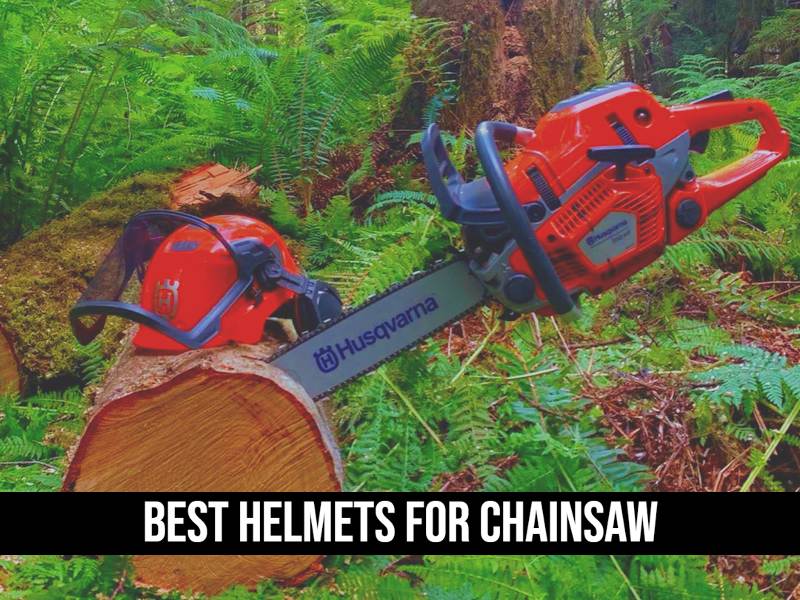
7 Best Helmets For Chainsaw – Tested & Compared 2023
In the United States alone, there are approximately 36,000 chainsaw-related injuries each year that require emergency treatment.
To minimize the risk of injury, it’s essential to wear the correct safety gear, including a helmet. Let’s take a closer look at the top seven helmets for chainsaw protection.
1. TR Industrial 88011 Helmet – Editor’s Pick
Pros
- 2 types of safeguards (plastic and mesh visors)
- One size for all
- Removable earmuffs
- Safe and secure as ANSI and CE certified
Cons
- No chin strap included
Color: Orange | Adjustable circumference: 20 – 24.5 inches | Material: Polycarbonate | Removable Earmuffs: Yes | Noise Reduction: 26 dB | Weight: 2.6 pounds
The TR forestry helmet has got you covered whether you’re operating chainsaws, brush cutters, or trimmers. Adjustable/removable earmuffs are a standout feature of this helmet.
With an SNR (Noise Reduction) of 26 dB, you can rest assured that your hearing will be protected even in the noisiest of environments. And if you don’t need the earmuffs, simply remove them and you’re good to go.
The helmet’s plastic visor is another key component. It protects your face and eyes from flying wood chips and other hazards.
But if you prefer a mesh visor, that’s an option too. The helmet comes with both types of visors, which are lightweight and interchangeable depending on your needs.
One of the best things about the TR Industrial Forestry Helmet is how well it secures your head. With a handy dial knob, adjusting the circumference is simple. The helmet fits head sizes from 52-62 centimeters, or 20 to 24.5 inches, making it suitable for a wide range of wearers.
Safety is paramount when it comes to helmets, and this one certainly delivers. It has an ANSI rating of Z89.1-2003, which means it meets or exceeds safety standards set by the American National Standards Institute. All parts are also CE and ANSI-approved, giving you peace of mind that you’re wearing a quality product that has been thoroughly tested and approved.
But enough about technical specifications – let’s talk about how this helmet looks and feels. It’s sleek and stylish, with a matte black finish that’s sure to turn heads.
And when you put it on, you’ll immediately notice how comfortable it is. The padding inside the helmet is soft and supportive, and the adjustable chin strap ensures a secure fit.
2. Pfanner Protos Helmet
Pros
- Provides convenience by allowing the earmuffs to be pushed backward
- Protects the user from compromising on essential safety equipment
- Allows the user to keep the helmet on when they need to talk
- Even when working in slope or above positions, fits flawlessly.
Cons
- The chin strap connection can be fragile and requires careful adjustment to avoid breaking
Color: Orange/Grey | Adjustable circumference: 21.1 to 24.4 inches | Material: Acrylonitrile Butadiene Styrene | Weight: 3.91 pounds
The Pfanner Protos Helmet is ANSI Z133 certified and in compliance with EN 397 and EN 12492. This means that it meets the highest safety standards for head protection, regardless of whether it is used on a slope or above a slope. You can trust that your head is well-protected when you’re wearing this helmet.
But safety isn’t the only thing that matters. Comfort and fit are also important, especially when you’re working long hours. Thankfully, the Protos Helmet fits flawlessly.
We’ve tested it out on a variety of head sizes, and it always feels snug and secure. And because it’s designed to minimize snagging on branches, you don’t have to worry about getting caught on anything while you’re working.
One of the things we love about this helmet is the way it incorporates hearing and facial protection into the head protection’s shell. It’s a smart design choice that makes the helmet even more effective at keeping you safe. You don’t have to worry about wearing separate ear muffs or a face shield – it’s all built right in.
The Pfanner Helmet also features a ventilation gate. When you’re working outside in hot weather, it’s easy to get overheated and uncomfortable.
But with this helmet, you can open the ventilation gate and let cooling air enter from all sides. It’s a small but incredibly useful feature that makes a big difference in your comfort level.
And finally, let’s talk about adjustability. When you’re out in the field, this Helmet is incredibly easy to adjust with only two fingers.
You want to avoid fumbling around with complicated adjustments when you’re working. A removable ear muff and shield give you greater control over comfort if you don’t need them.
3. Husqvarna B0030MIHBY ProForest Helmet
Pros
- UV protection
- Rain neck protector
- Features a new Hi-Viz Orange color for improved safety.
- Lightweight only 2.25 pounds
Cons
- When worn in bright sunshine, the translucent nature of the helmet can cause a dazzling glare in the eyes.
Color: Hi-Viz Orange | Material: vinyl | Noise Reduction: 25 dB | Weight: 2.25 pounds
Starting with the size of the helmet is designed to fit most people, ensuring that everyone can have access to the same level of safety. The hard hat with UV protection is a bonus, as it protects your head from the sun’s harmful rays while you are working outside.
The adjustable 6-point suspension is a game-changer. It allows for a comfortable fit no matter the size or shape of your head. As a result, the helmet stays in place while you work, preventing any possible accidents.
The hearing protection with a 25 dB (A) NRR is fantastic. It protects your hearing from the loud noise produced by chainsaws, which can be incredibly loud. Working for this long without feeling tired or damaging your hearing is possible with this feature.
The face screen is one of the most important features of the helmet as it protects your face from any flying debris that the chainsaw may kick up. It is especially helpful when cutting in tight spaces where branches and leaves are present.
Finally, the rain neck protector is a bonus. It keeps you dry during those rainy days when you still need to work. Furthermore, it prevents water from running down your neck and causing discomfort.
The Husqvarna Chain Saw Helmet meets the requirements of ANSI Z89.1-2003 Class G-E-C, ensuring that it is safe to use while working with a chainsaw. This standard provides a high level of protection against impact, penetration, and electrical hazards.
For those who prioritize ear protection, the new Hi-Viz orange color is a great choice. Not only is it stylish, but it also provides better visibility and protection in low-light conditions.
When the mask is in its up or down position, the head strap swings firmly into place with an easy click. It prevents any potential hazards by keeping your helmet in place while you work.
4. Oregon Chainsaw Safety Helmet
Pros
- Comes with a 2-year manufacturer warranty
- Face shield keeps wood chips off the face
- Easy to adjust for sweatbands with the adjustment knob
- 6 ventilation holes for breathability
Cons
- The face shield does not go all the way down, leaving a gap of about 3-4 inches between the shield and the face
Color: Yellow | Material: Plastic | Warranty: 2 year | Noise Reduction: 26 dB | Weight: 2.2 pounds | Certifications: ANSI
The Oregon Chainsaw Safety helmet is made from impact-resistant material that can withstand even the toughest of impacts. As a result of the six ventilation holes, the helmet provides high breathability, keeping the user cool and comfortable. As a result, this capability is particularly useful when working in hot, humid conditions.
This Safety Helmet also features an easy-adjust harness with six points. The helmet stays securely in place with the help of this harness, which gives a precise and snug fit. It is particularly useful when working in challenging environments, where maximum flexibility and mobility are needed without compromising safety.
Its detachable sun peak makes the Oregon Helmet a must-have for chainsaw operators. Sun’s peak protects users from direct sunlight, keeping them comfortable and allowing them to work for long periods.
Direct sunlight can be distracting and uncomfortable when working in bright and sunny conditions.
A standout feature of this Helmet is the articulated ear cups mounted on the cap. Designed to protect the user’s hearing while using a chainsaw, these ear cups provide maximum protection from loud noises.
Working in noisy environments, where the user needs to hear instructions and communicate effectively, this feature is especially useful.
Stainless steel mesh visors are another feature that sets them apart from the competition. This visor provides excellent protection from flying debris and other hazards, ensuring that the user remains safe and protected while using a chainsaw.
The flip-up/flip-down functionality allows for easy and quick access to the visor, making it easy to use and adjust as needed.
Oregon Safety Helmets have been tested to meet ANSI Z89.1-2009 Type I, Class E, G, and C requirements. It provides maximum protection against a variety of hazards, making it a must-have for chainsaw operators.
5. Stihl ProMark Forestry Helmet
Pros
- A complete forestry helmet
- The ANSI Z87.1-2003 standard for visors applies to eye and face safety devices
- Adjustable fit for most sizes.
- Parts are easily available
Cons
- Must raise visor to wipe sweat from the brow
Color: Black, Orange | Material: Plastic | Certification: ANSI | Weight: 2.4 pounds | Noise Reduction: 25 dB
The six-point ratchet-style suspension mechanism is one of the helmet’s most notable features. The mechanism ensures that any head size or shape will fit securely and comfortably. During extended periods of use, the lightweight ABS thermoplastic shell also reduces strain on the neck and shoulders by absorbing shock.
But what about hearing protection? Stihl has got you covered there, too. The ProMark helmet includes NRR 25 earmuffs that help to muffle engine and tool noise. And don’t worry about feeling like you’re in a soundproof room – while the earmuffs are effective, they still allow you to hear voices and other important sounds in your environment.
This full-facial, robust steel mesh screen is intended to shield your face from flying objects. We’ve taken this helmet on countless outdoor excursions, and we can attest to the effectiveness of this visor. It’s sturdy enough to deflect even the most stubborn twigs and branches, while still allowing for clear visibility.
And what about bad weather? The ProMark helmet has got that covered, too. The built-in rain gutter directs rain away from your face during inclement weather, making sure that you can stay focused on the task at hand.
Last, but not least, it’s important to note that the Stihl ProMark Forestry Helmet meets the standards of ANSI S3.19-1974 for earmuffs, which have a Noise Reduction Rating (NRR) of 25 dB(A). These standards are in place to ensure that your hearing is protected to the highest degree possible.
6. NEIKO 53880A Forestry Helmet – Budget Pick
Pros
- Adjustable Knob for Perfect Fit
- Ventilated for Comfort
- Noise reduction and hearing block of up to NRR 22 decibels and SNR 25.9 dB range ideal for chainsaws
- Clear and Mesh Shields Included
Cons
- No padding on the harness inside so it can hurt.
Color: Yellow | Material: Plastic, Steel Mesh | Removable Earmuffs: Yes | Weight: 2.49 pounds | Noise Reduction: 25.9 dB
The NEIKO Forestry Helmet comes with a face shield and earmuffs, making it a complete protective gear solution for chainsaw users.
When you’re working with chainsaws, it’s crucial to have protective gear that covers your face and ears, as well as your head. This helmet offers all three in one package, making it an essential piece of equipment for anyone working with chainsaws.
One of the best features of this helmet is its versatility. While it was designed for use in forestry environments, it can be worn by anyone who needs protection in a forest setting. Whether you’re a logger, a carpenter, or a DIY enthusiast, this helmet will provide the protection you need.
It includes a yellow hard hat helmet, a clear face shield, a steel mesh face shield, and adjustable ear muffs. This helmet accessory set is complete and ready to use right out of the box. You won’t have to worry about buying additional pieces of protective gear to get the level of protection you need.
The helmet also has a comfortable fit. Hard hats, shields, and earmuffs have dials that adjust the fit, ensuring they stay securely on your head. When you’re using a chainsaw, you won’t have to worry about the helmet moving around or falling off.
NEIKO Helmets are among the best in terms of protection. As well as providing excellent visibility, the clear face shield protects you from flying debris.
A steel mesh face shield can also protect larger pieces of debris while allowing air to circulate your face. Earmuffs offer excellent noise reduction, protecting your ears from chainsaws and other loud noises.
7. Felled Forestry Chainsaw Helmet
Pros
- A sturdy and comfortable helmet that meets the ANSI rating
- Earmuffs that rotate 360 degrees and lock up and down
- Face shields that pivot up and down
- Protects head, face, and ears
Cons
- Cross-strap tabs may be incorrectly installed and cause issues with fit for new users
Color: Green | Material: Polypropylene, polycarbonate, PVC, metal | Noise Reduction: 30 dB | Weight: 2.16 pounds
The Felled Forestry Chainsaw Helmets are tested and used by our team and found them extremely safe and secure. It features a high-density impact cap that meets ANSI Z89.1 and CE EN397:2012+A1:2012 safety standards. The polypropylene shell and cloth head cradle offers additional protection against impact injuries.
One of the standout features of this helmet is its lightweight design. As an arborist or forestry worker, you already have enough heavy equipment to carry around, so the last thing you need is a bulky helmet. The Felled Forestry Chainsaw Helmet is designed to be lightweight, so you can wear it for extended periods without experiencing neck or shoulder strain.
In addition to its adjustable design, this helmet stands out from the rest. You can adjust the helmet’s top vents and back crank to fit your head down to 6-7/8 inches (17.5cm).
This ensures a snug and comfortable fit for all head sizes. You won’t have to worry about the helmet slipping or moving around while you work, which could be a safety hazard.
The Felled Helmet comes with two pairs of earmuffs, a metal mesh visor, and a polycarbonate visor. The earmuffs are lightweight, detachable, and flip up and outward when not in use.
Their 23dB signal-to-noise ratio (SNR) [study on the importance of SNR for ears] and 30dB noise reduction make them the perfect hearing protection for the workplace.
Face shields provide full-face protection with impact-resistant polycarbonate visors that meet CE EN 166 1B standards. You can prevent fogging in humid or hot environments by switching to the integrated mesh face screen.
How long does a chainsaw helmet last?
On average, a chainsaw helmet can last anywhere from 6 months to 2 years with regular use. However, the lifespan can be extended up to three years if the helmet is well-maintained and not subjected to any harsh impacts or damage.
The frequency of use, quality of materials, and exposure to extreme weather conditions also affect the lifespan of a chainsaw helmet. If the helmet is used frequently, it may wear out faster than a helmet that is only used occasionally.
Additionally, if the helmet is exposed to harsh sunlight or extremely cold temperatures, it may deteriorate faster than one that is stored in a cool, dry place.
Regular maintenance, such as cleaning and inspecting the helmet for cracks or damage, can help extend its lifespan. It is also essential to replace the helmet if it has been involved in an impact or if the straps or other parts are worn out.
How do I maintain and clean my chainsaw helmet?
To maintain and clean a chainsaw helmet, follow these steps:
- Check the manufacturer’s instructions first. They provide specific cleaning and maintenance recommendations for your helmet.
- Remove debris and dirt from the helmet’s surface using a soft-bristled brush or cloth.
- Clean the helmet by wiping it with a damp cloth soaked in warm soapy water or dish detergent. Allow the detergent to work its magic for a moment, then rinse the cloth and wipe the helmet again to remove any remaining dirt or soap residue.
- For helmets with a visor, use a soft-bristled toothbrush or Q-tip to clear any dirt or debris from the visor seals or vents. Stubborn dirt or debris can be dislodged with warm water.
- Thoroughly dry the helmet with a clean, dry microfiber cloth.
- Store the chainsaw helmet appropriately in a cool, dry place away from direct sunlight and extreme temperatures. Keep it away from chemicals or solvents that could potentially harm the helmet’s materials.
8 Features To Consider While Buying Best Helmets For Chainsaw
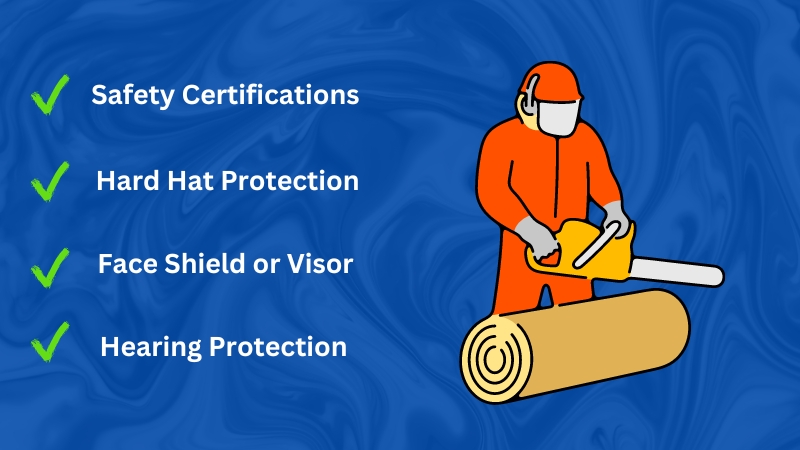
A reliable and high-quality helmet is an essential piece of chainsaw safety equipment. Besides protecting your head from impact and laceration injuries, a helmet can also protect you from debris and sawdust that can irritate your respiratory system.
Let’s take a closer look at some of the key features you should consider when shopping for a chainsaw helmet
1. Safety Certifications
When buying a helmet for a chainsaw, it is important to consider safety certifications. These certifications ensure that the helmet meets the minimum safety requirements set by regulatory bodies.
For industrial helmets, the European Norm (EN) 397 sets the standard. In the United States, ANSI Z89.1, the standard for protective helmets, is another important certification. A widely recognized certification in North America is the Canadian Standards Association (CSA) Z94.1.
These safety certifications guarantee that the helmet provides adequate impact, penetration, and electrical protection. They also ensure that the helmet has undergone rigorous testing to determine its effectiveness.
2. Hard Hat Protection
Chainsaw work involves inherent risks, and head injuries can be severe or even fatal. Using a hard hat protects falling objects and accidental contact with the chainsaw.
It typically consists of a reinforced outer shell made of durable materials such as high-density polyethylene or ABS plastic. It does not only protect the wearer from direct blows but also distributes the force of impact to reduce the risk of skull fractures.
3. Face Shield or Visor
Operating a chainsaw poses significant risks, including flying debris and wood chips that can cause severe eye injuries. A face shield or visor provides a protective barrier, shielding the face and eyes from these hazards. It is typically made of transparent and impact-resistant materials such as polycarbonate.
Face shields and visors should provide adequate coverage to protect the eyes, nose, and mouth. To ensure safety and efficiency, it should provide excellent visibility and minimize fogging.
4. Hearing Protection
Chainsaws produce loud and continuous noise, which can lead to hearing loss over time. Therefore, it’s essential to choose a helmet that offers adequate protection for your ears.
Helmets with built-in ear muffs or earplugs are the most effective in reducing noise levels. The ear muffs or earplugs should have a Noise Reduction Rating (NRR) of at least 22 decibels to effectively protect your ears from the chainsaw’s noise.
The Occupational Safety and Health Administration (OSHA) recommends a maximum exposure of 85 decibels for eight hours in a workday.
Chainsaw noise can reach up to 110 decibels, which can cause hearing damage in as little as 30 minutes. Chainsaw helmets with built-in ear protection, such as ear muffs or earplugs, can help reduce the risk of hearing damage and provide a safer work environment.
5. Comfort and Ventilation
Chainsaw work often involves strenuous physical activity and extended periods of wear, making comfort a top priority. An adjustable suspension system and ample padding ensure a snug and comfortable fit, reducing discomfort and fatigue. The helmet must also be ventilated to maintain a cool and breathable environment.
Ventilated helmets allow heat to escape and fresh air to circulate, preventing excessive sweating and overheating. As a result of this ventilation, chainsaw operations become safer and more efficient, as well as more comfortable.
6. Chin Strap
The chin strap is designed to keep the helmet securely in place during use, preventing it from falling off or shifting around. This is especially important when working with a chainsaw, which can cause sudden movements and jarring impacts.
A proper chin strap should be adjustable and fit snugly under the chin, but not too tightly. It should also be made of durable materials that can withstand the wear and tear of regular use. A chin strap that is too loose or weak can compromise the safety of the helmet and put the user at risk of injury.
7. Compatibility with Accessories
A good helmet should be able to accommodate different add-ons to enhance its functionality and overall safety. For instance, a helmet with earmuffs can offer protection against loud noises that can cause hearing damage. Similarly, a face shield or visor can protect the face from debris, wood chips, and other flying objects that may cause injury.
Other accessories that can be attached to a helmet for chainsaw use include reflective strips, neck shades, and chin straps. Reflective strips can be especially useful when working in low-light conditions or around traffic.
Neck shades, on the other hand, can provide much-needed relief from the sun’s heat. As well as keeping the helmet in place, chin straps can also prevent it from falling off during an accident.
It is important to make sure that the helmet you choose is compatible with the specific accessories you need, as not all helmets are designed to accommodate all types of accessories. This can ensure that the accessories fit properly and function effectively, providing the maximum level of safety and comfort for the user.
8. Ease of Adjustment
A helmet that can be easily adjusted ensures a secure and comfortable fit for the wearer. The ability to adjust the suspension system and chin strap allows for customization based on individual head sizes and shapes.
This ensures a snug fit, minimizing movement and providing maximum protection during operation. Additionally, easy adjustment promotes convenience and efficiency, allowing the wearer to quickly and effortlessly modify the helmet’s fit as needed.
Conclusion
When it comes to choosing the best helmet for chainsaws, there are several factors to consider such as comfort, durability, and safety.
After extensive research and analysis, we have come up with two top picks – the TR Industrial Forestry Helmet which is our Editor Pick, and the NEIKO Forestry Helmet which is our Budget Pick.
Safety can be severely compromised if the wrong chainsaw helmet is chosen. Serious injuries, including head and facial injuries, hearing loss, and even death, may result. Non-approved helmets may not provide adequate protection, and helmets designed for other purposes may not protect against chainsaw-specific hazards.
To ensure safe chainsaw operation, it’s imperative to invest in a chainsaw helmet that meets relevant safety standards. A helmet must also be maintained and replaced regularly to ensure continued protection.
Pros
- 2 types of safeguards (plastic and mesh visors)
- One size for all
- Removable earmuffs
- Safe and secure as ANSI and CE certified
Cons
- No chin strap included
FAQs
Can I use any helmet with a chainsaw?
No, it is not recommended to use just any helmet with a chainsaw. Chainsaws can create flying debris which can lead to serious injuries if the helmet doesn’t have the appropriate protection. Additionally, helmets designed for chainsaw use often have built-in ear protection to reduce the noise and vibrations that can cause hearing damage and fatigue. Therefore, it is important to use a helmet specifically designed for chainsaw use to ensure your safety and protection from potential hazards.
Are there helmets with built-in communication systems?
Yes, there are helmets with built-in communication systems. These helmets are designed to provide a seamless communication experience for riders, especially those who ride in groups or with passengers. The communication systems are typically built into the helmet’s padding and allow riders to communicate with each other using either a wired or wireless connection. Some helmets also feature Bluetooth connectivity, allowing riders to connect their phones and other devices to the helmet.
Is there a weight limit for chainsaw helmets?
No, There is no specific weight limit for chainsaw helmets. However, it is important to choose a helmet that is comfortable to wear for extended periods, as using a chainsaw can be physically demanding. It is recommended to try on different helmets and choose one that fits well and does not cause discomfort or strain on the neck or shoulders.
Can I use a chainsaw helmet in wet or rainy conditions?
Yes, you can use a chainsaw helmet when it is raining or wet. Chainsaw helmets are designed to protect the user’s head from falling debris and the chainsaw’s cutting chain. Many chainsaw helmets come with a waterproof or water-resistant shell that can withstand wet or rainy conditions. However, it is important to note that while the helmet may protect your head from falling debris, it does not protect against electric shock or slipping hazards on wet surfaces.
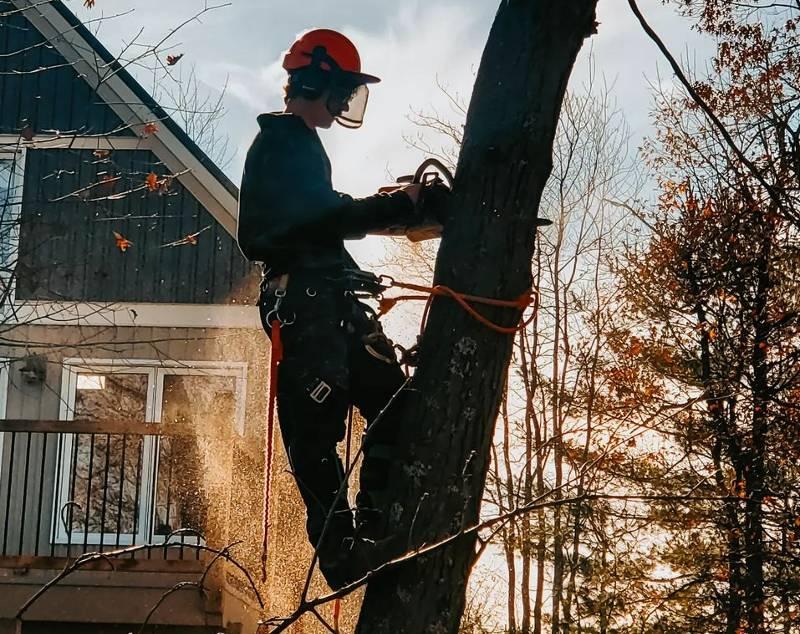
I am Senior Editor and CEO and I have been a chainsaw enthusiast for over 12 years. As a passionate chainsaw enthusiast, I have got a wealth of knowledge and experience with chainsaws, and I am constantly striving to expand my expertise and knowledge. Read More!
